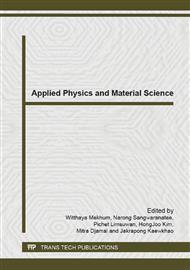[1]
K.J. Singh, N. Singh, R.S. Kaundal, K. Singh, Gamma-ray shielding and structural properties of PbO-SiO2 glass, Nucl. Instr. and Meth. B. 266 (2008) 944–948.
DOI: 10.1016/j.nimb.2008.02.004
Google Scholar
[2]
S.R. Manohara, S.M. Hanagodimath, L. Gerward, Photon interaction and energy absorption in glass: A transparent gamma ray shield, J. Nucl. Mater. 393 (2009) 465-472.
DOI: 10.1016/j.jnucmat.2009.07.001
Google Scholar
[3]
Barite (BaSO4) [Online], Available : http: /pandsgroup. com/th/products. htm.
Google Scholar
[4]
S.R. Manohara and S.M. Hanagodimath, Studies on effective atomic numbers and electron densities of essential amino acids in the energy range 1 keV–100 GeV, Nucl. Instr. and Meth. B. 258 (2007) 321-328.
DOI: 10.1016/j.nimb.2007.02.101
Google Scholar
[5]
H. Singh, K. Singh, L. Gerward, K. Singh, H.S. Sahota, R. Nathuram, ZnO–PbO–B2O3 glasses as gamma-ray shielding materials. Nucl. Instr. and Meth. B. 207 (2003) 275-262.
DOI: 10.1016/s0168-583x(03)00462-2
Google Scholar
[6]
K. Singh, H. Singh, V. Sharma, R. Nathuram, A. Khanna, R. Kumar, S.S. Bhatti, H.S. Sahota, Gamma-ray attenuation coefficients in bismuth borate glasses. Nucl. Instr. and Meth. B. 194 (2002) 1–6.
DOI: 10.1016/s0168-583x(02)00498-6
Google Scholar
[7]
K. Singh, R. Kaur, Vandana, V. Kumar, Study of effective atomic numbers and mass attenuation coefficients in some compounds, Rad. Phys. Chem. 47 (1996) 535–541.
DOI: 10.1016/0969-806x(95)00057-5
Google Scholar
[8]
N. Singh, K.J. Singh, K. Singh, H. Singh, Comparative study of lead borate and bismuth lead borate glass systems as gamma-radiation shielding materials, Nucl. Instr. and Meth. B. 225 (2004) 305–309.
DOI: 10.1016/j.nimb.2004.05.016
Google Scholar
[9]
S. Singh, A. Kumar, D. Singh, K.S. Thind, G.S. Mudahar, Barium–borate–flyash glasses: As radiation shielding materials, Nucl. Instr. and Meth. B. 266 (2008) 140–146.
DOI: 10.1016/j.nimb.2007.10.018
Google Scholar
[10]
G.J. Hine, The effective atomic numbers of materials for various gamma ray interactions. Phy. Rev. 85 (1952) 725–737.
Google Scholar
[11]
L. Gerward, N. Guilbert, K.B. Jensen, H. Levring, X-ray absorption in matter. Reengineering XCOM. Radiat. Phys. Chem. 60 (2001) 23–24.
DOI: 10.1016/s0969-806x(00)00324-8
Google Scholar
[12]
L. Gerward, N. Guilbert, K.B. Jensen, H. Levring, WinXCom–a program for calculating X-ray attenuation coefficients. Radiat. Phys. Chem. 71 (2004) 653–654.
DOI: 10.1016/j.radphyschem.2004.04.040
Google Scholar
[13]
Green rhino energy, Solar glass & mirrors [Online], Available : http: /www. greenrhinoenergy. com/solar/technologies/solar_glass. php.
Google Scholar
[14]
D.F. Jackson, D.J. Hawkes, X-ray attenuation coefficients of elements and mixtures, Phys. Rep. 70 (1981) 169–233.
DOI: 10.1016/0370-1573(81)90014-4
Google Scholar
[15]
M. Kurudirek, İ. Türkmen, Y. Özdemir, A study of photon interaction in some building materials: High-volume admixture of blast furnace slag into Portland cement, Radiat. Phys. Chem. 78 (2009) 751–759.
DOI: 10.1016/j.radphyschem.2009.03.070
Google Scholar


